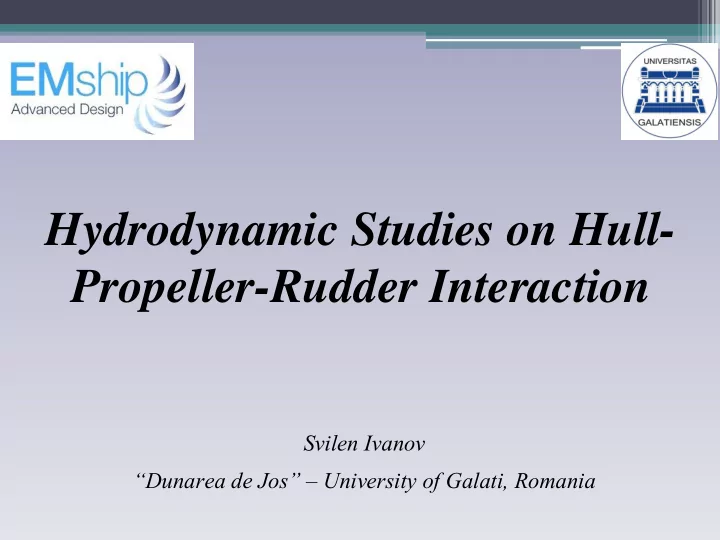

Hydrodynamic Studies on Hull- Propeller-Rudder Interaction Svilen Ivanov “Dunarea de Jos” – University of Galati, Romania
Paper Outline Introduction Numerical Approach Grid Generation Results and Discussions Concluding Remarks
Introduction Investigation of the hydrodynamic performance of a modern benchmark container ship hull is presented in the paper Numerical simulations is performed for the flow around the bare hull at first, then around the hull with propeller, hull with rudder and finally around the whole ensemble, so taking into consideration the effect of propeller – rudder as a whole.
Introduction Configurations like propeller Open Water test, Self Propulsion test and deflected rudder are studied as well.
Numerical Approach Efficient potential flow panel method is used to predict important quantities like waves and wave resistance All the viscous flow computation, is made by means of the XCHAP module of the SHIPFLOW CFD code, which is a finite volume RANS solver.
Numerical Approach One point closure turbulence approach is attained trough the EASM model The propeller is modeled by lifting line method
Numerical Approach Boundary conditions The boundary conditions are formulated in terms of pressure, velocity, turbulent kinetic energy, and turbulent frequency.
Grid Generation An H - O type, structured grid of 2.2 million cells is created to cover the entire computational domain along the bare hull
Grid Generation Computational grid • The computational grid is clustered longitudinally, radially and vertically near the ship hull • The clustering is made appropriate for accurate numerical solution • y+=1
Grid Generation Overlapping grid • Chimera technique was used – the additional grids for the propeller and the rudder can be fitted together and overlap at the junction points.
Results and Discussions The objective of the present study is: To provide the specific knowledge to simulate and analyze numerically the viscous interaction that appears and develops between hull, propeller and/or rudder Validation is provided for: Wave pattern of bare hull Axial velocity distribution Total resistance for bare hull Propeller Open Water Characteristics Total resistance for Hull with rudder
Results and Discussions Wave pattern • The shape and the contours are in very good match with the reference result
Results and Discussions Axial velocity bare hull • The comparison shows very good agreement with the reference result
Results and Discussions Total resistance validation for bare hull • The error at the design speed is satisfactory
Results and Discussions Propeller Open Water validation η 0 diagram Kt diagram Kq diagram The minor inconsistencies that appear in the figures can be explained by the fact that the method does not consider the surface of blade
Results and Discussions Total resistance validation for hull with rudder • The method used shows very good agreement at the design speed.
Results and Discussions deflected rudder STB PS 30˚ 20˚ 10˚ 0˚ - 10˚ - 20˚ - 30˚ • The difference of the pressure between- 30˚ and +30˚ due to the right handed propeller, is obvious
Results and Discussions Axial velocity comparison Bare hull Hull with propeller Hull with rudder Hull with propeller and rudder
Results and Discussions Pressure distribution comparison Bare hull Hull with propeller Hull with rudder Hull with propeller and rudder
Concluding Remarks Study of Hull – Propeller - Rudder interaction is performed Validation for wave pattern, total resistance for bare hull, axial velocities for bare hull, propeller open water characteristics, total resistance for hull with rudder The influence caused by the presence of propeller and rudder is clearly shown The method allows including of a drift angle as well as combination with different rudder angle
Thank you for your attention
Recommend
More recommend